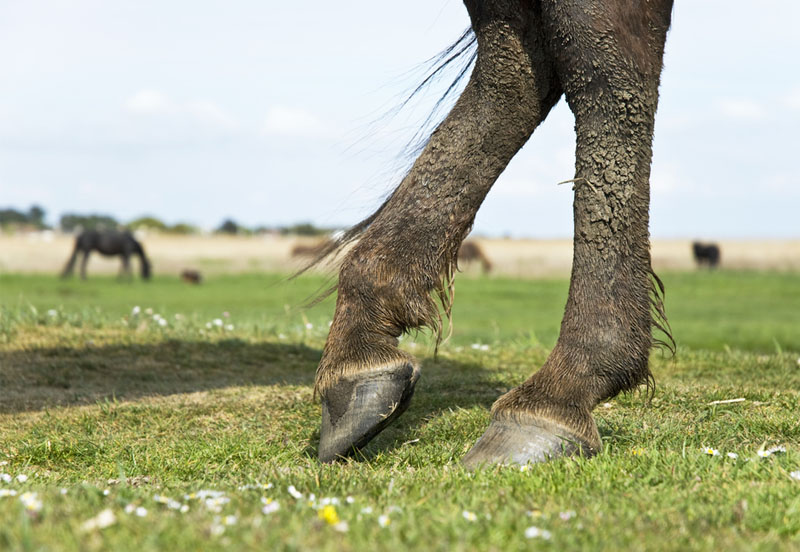
I loathe winter. I loathe it because of mud fever, which is the ultimate thorn in my side. There’s many an hour that I’ve spent in pitch darkness, under bitter winds and lashing rain, hosing down legs, removing scabs and furiously towel-drying.
It’s an experience that almost every horse owner has had to deal with at some point in their horsey life — it’s only those lucky few who haven’t!
What is mud fever in horses?
Mud fever, one of winter’s many struggles as an equestrian, is a skin infection caused by the bacterium Dermatophilus congolensis. It’s found in the environment and lives in scabs as little spores.
When these spores are damp, they become active and germinate to produce threadlike tentacles that penetrate living skin, causing inflammatory reactions. These inflammations can become infected, swollen and extremely uncomfortable.
Below are some top tips to help prevent and treat mud fever this winter, and to help you beat the bacterium, without breaking the bank.
Mud fever prevention ideas
Use surgical spirit
One of the main problems with mud fever is that the damp weather in winter jeopardises the integrity of skin, making it easy for the spores to germinate and spread. Surgical spirit is my go-to product for combatting this as it hardens the skin and gets rid of germs.
Throughout the warmer months, when washing my horse off, I add surgical spirit to a bucket of water and apply to the legs liberally, without rinsing. This helps harden the skin and gives the legs some added, natural protection.
Find some pig oil
This sounds gross, but in reality, it’s a life saver! You can pick up pig oil relatively cheaply from any horse supplies shop.
Apply to your horse’s legs every couple of days, and don’t be afraid to slosh it on—the more you use, the better. The pig oil acts as a defensive barrier against the elements, which allows the mud to just run down the horse’s legs. You’ll wake up each morning and they’ll still be lovely, clean and dry.
Keep the tail of your horse short and plait it up for turning out
A long, mud-clotted tail that swings and rubs between the hind legs can irritate the skin, causing cuts and providing access for bacteria to thrive. Tidy tails reduce the chance of aggravated mud fever, keep the area clean and save hours spent washing and brushing out knots.
Don’t clip out your horse’s legs
I agree they can look so much smarter when clipped but resist the urge!
Removing the fur on legs also removes their natural barrier. A dense coat offers warmth and protection, while acting as an impermeable layer that stops the wet and mud from seeping on to the skin. ‘Au natural’ is my new mantra!
Mud Fever Treatment Options
If you have succumbed to the dreaded mud fever, then don’t panic! Follow these steps to effectively manage and treat the issue.
Wash your horse’s legs
With warm water wash your horse’s legs, then scrub with a water and hibiscrub solution. Be sure to allow at least two minutes for the scabs to soak before washing the treatment off.
Remove any scabs
Remove scabs, but be as careful as possible and take your time. It can be quite painful for your horse, which is why it’s best to soak the legs for as long as you can. Don’t be alarmed if there’s some blood during the process.
Thoroughly towel dry
Once you have removed the scabs, thoroughly towel dry the legs. This is my least favourite part of our winter routine, but it’s actually the most important. An endless supply of towels can be pricey though, so a great way to get through mud fever season is to buy them second hand.
Apply an antibacterial cream
Now the legs are bone-dry, apply an antibacterial cream to where the scabs were. Flamazine is generally prescribed by vets and while it is effective, it’s also very expensive. A cheaper yet equally good alternative is to use an over-the-counter antibacterial cream, such as Sudocrem.
Just be sure to avoid products like Vaseline, which don’t have any antiseptic properties, and instead help to harbour bacteria.
Bandage your horse’s legs
Finally, bandage those legs. This helps wick away any moisture left on the fur and keeps the legs properly clean and dry.
In summary
During winter mud fever is part and parcel of horse ownership in the UK, unless you’re extremely fortunate to have a hardy horse.
Sadly my horse isn’t hardy. If you’re unlucky, like me, the good news is that with enough good, old fashioned, stable management it can be controlled.
If you have any tips for combatting mud fever, leave a comment and share your advice!


